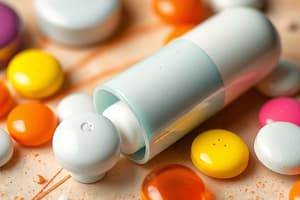Podcast
Questions and Answers
What are some common instruments used for pharmaceutical measurement of volume?
What are some common instruments used for pharmaceutical measurement of volume?
Micropipettes, cylindrical and conical graduates, calibrated syringe, pipette
Why is it recommended to select a graduate with a capacity equal to or just exceeding the volume to be measured?
Why is it recommended to select a graduate with a capacity equal to or just exceeding the volume to be measured?
To minimize errors in measurement. The smaller the diameter of the measuring equipment, the more accurate the measurement.
What is the importance of focusing on the equipment and methods used in the accurate measurement of therapeutic and pharmaceutical materials?
What is the importance of focusing on the equipment and methods used in the accurate measurement of therapeutic and pharmaceutical materials?
To ensure proper dosing and effectiveness of the medication.
What are the most commonly used semisolid dosage forms for external application to the skin?
What are the most commonly used semisolid dosage forms for external application to the skin?
List the volume measurement instruments in order of accuracy from highest to lowest based on the text.
List the volume measurement instruments in order of accuracy from highest to lowest based on the text.
What are some sources of errors in weight measurement according to the text?
What are some sources of errors in weight measurement according to the text?
Define percentage of error as mentioned in the text.
Define percentage of error as mentioned in the text.
What is the importance of recognizing the limitations of the instruments used in community pharmacy according to the text?
What is the importance of recognizing the limitations of the instruments used in community pharmacy according to the text?
Calculate the percentage of error in the volume measurement if a pharmacist measured 30 milliliters of a liquid using a graduated cylinder, but on subsequent examination found that actually measured 32 milliliters.
Calculate the percentage of error in the volume measurement if a pharmacist measured 30 milliliters of a liquid using a graduated cylinder, but on subsequent examination found that actually measured 32 milliliters.
In preparing a certain ointment, a pharmacist used 28.35 grams of zinc oxide instead of the 31.1 grams required. Calculate the percentage of error based on the desired quantity.
In preparing a certain ointment, a pharmacist used 28.35 grams of zinc oxide instead of the 31.1 grams required. Calculate the percentage of error based on the desired quantity.
If a graduate weighs 35.825 grams and when 10 milliliters of water are measured in it, the total weight becomes 45.835 grams, calculate the weight of the water and express any deviation from 10 grams as a percentage of error.
If a graduate weighs 35.825 grams and when 10 milliliters of water are measured in it, the total weight becomes 45.835 grams, calculate the weight of the water and express any deviation from 10 grams as a percentage of error.
A prescription calls for 800 milligrams of a substance. If after weighing it, the pharmacist finds that only 750 milligrams are obtained, what was the percentage of error in the first measurement?
A prescription calls for 800 milligrams of a substance. If after weighing it, the pharmacist finds that only 750 milligrams are obtained, what was the percentage of error in the first measurement?
Flashcards are hidden until you start studying
Study Notes
Pharmaceutical Measurement
- Common instruments used for measuring volume in pharmaceuticals: graduated cylinders, burettes, pipettes, and measuring cylinders.
- It's recommended to select a graduate with a capacity equal to or just exceeding the volume to be measured to minimize errors.
Importance of Accurate Measurement
- Accurate measurement of therapeutic and pharmaceutical materials is crucial, as it directly affects the efficacy and safety of the medication.
- Focus on equipment and methods is vital to ensure accurate measurements.
Semisolid Dosage Forms
- Commonly used semisolid dosage forms for external application to the skin: ointments, creams, and gels.
Volume Measurement Instruments
- Order of accuracy from highest to lowest: pipettes, burettes, graduated cylinders, and measuring cylinders.
Sources of Error
- Sources of error in weight measurement: instrumental errors, human errors, and environmental factors.
Percentage of Error
- Percentage of error: (|actual value - measured value| / actual value) × 100%.
Limitations of Instruments
- Recognizing the limitations of instruments used in community pharmacy is crucial to minimize errors and ensure accurate measurements.
Error Calculations
- If a pharmacist measures 30 mL but actually measures 32 mL, the percentage of error is: (|32 - 30| / 30) × 100% = 6.67%.
- If a pharmacist uses 28.35 g of zinc oxide instead of 31.1 g, the percentage of error is: (|31.1 - 28.35| / 31.1) × 100% = 9.06%.
- If a graduate weighs 35.825 g and 10 mL of water weighs 45.835 g, the weight of water is: 45.835 - 35.825 = 10.01 g. The percentage of error is: (|10.01 - 10| / 10) × 100% = 0.1%.
- If a prescription calls for 800 mg but only 750 mg is obtained, the percentage of error is: (|800 - 750| / 800) × 100% = 6.25%.
Studying That Suits You
Use AI to generate personalized quizzes and flashcards to suit your learning preferences.




